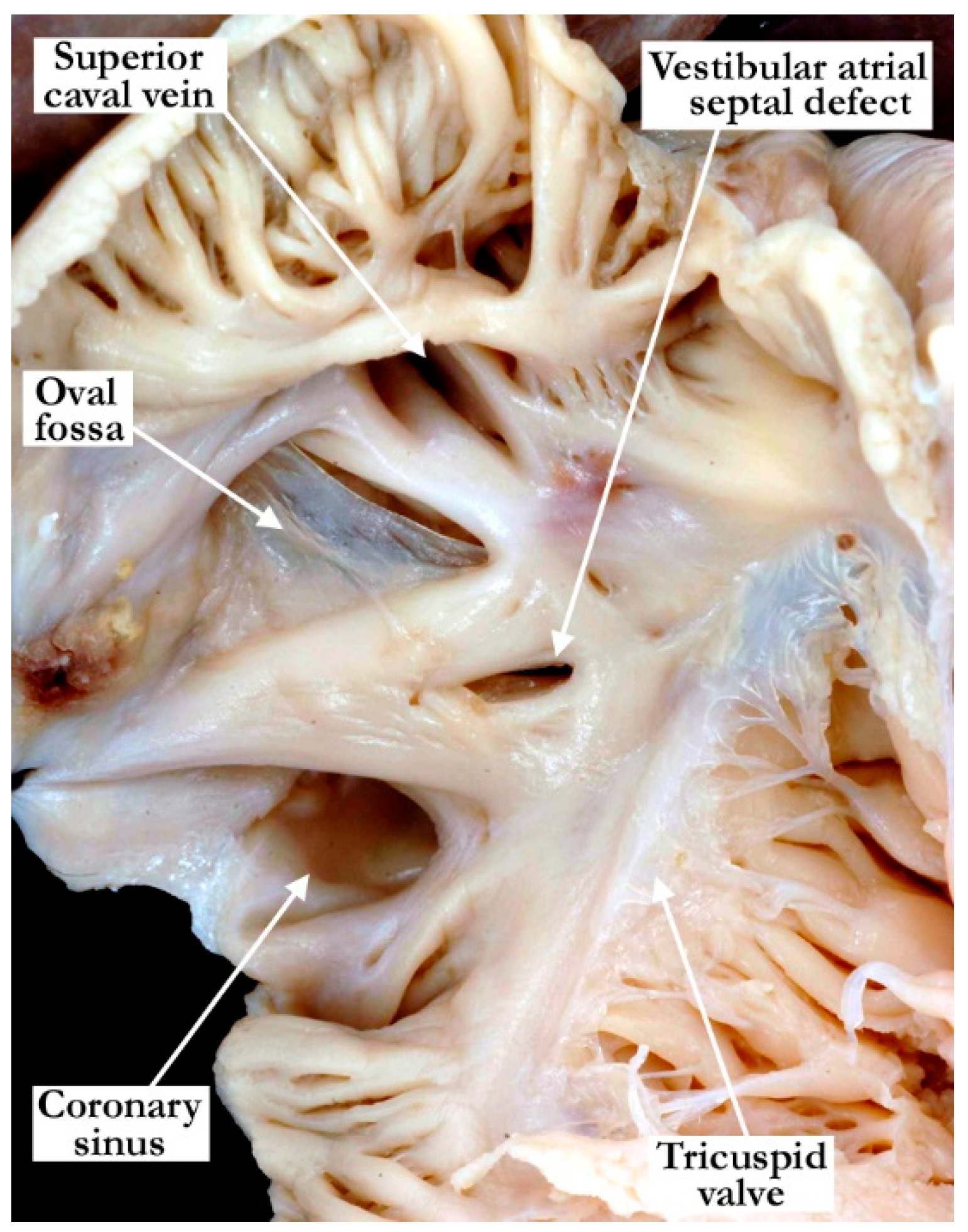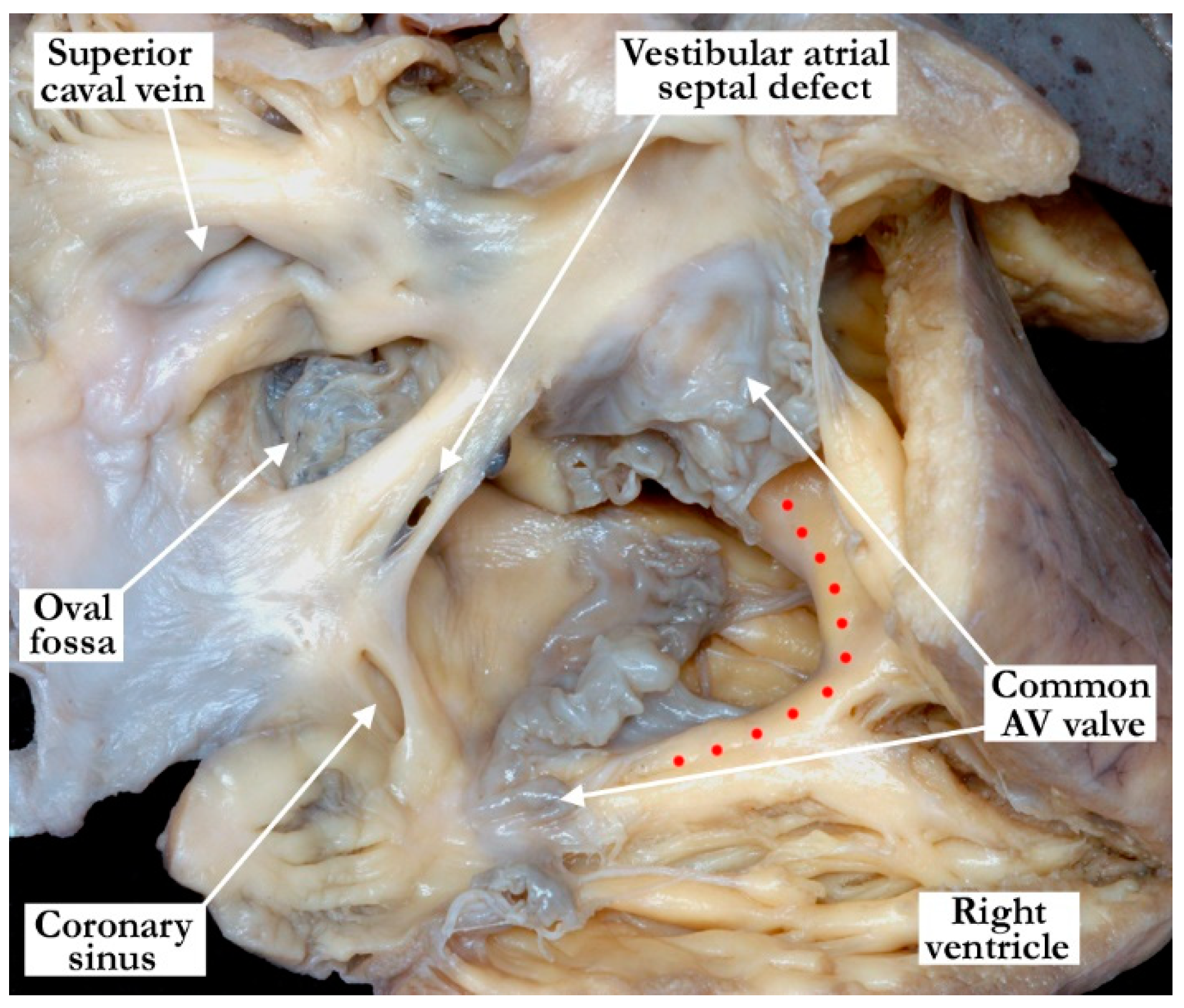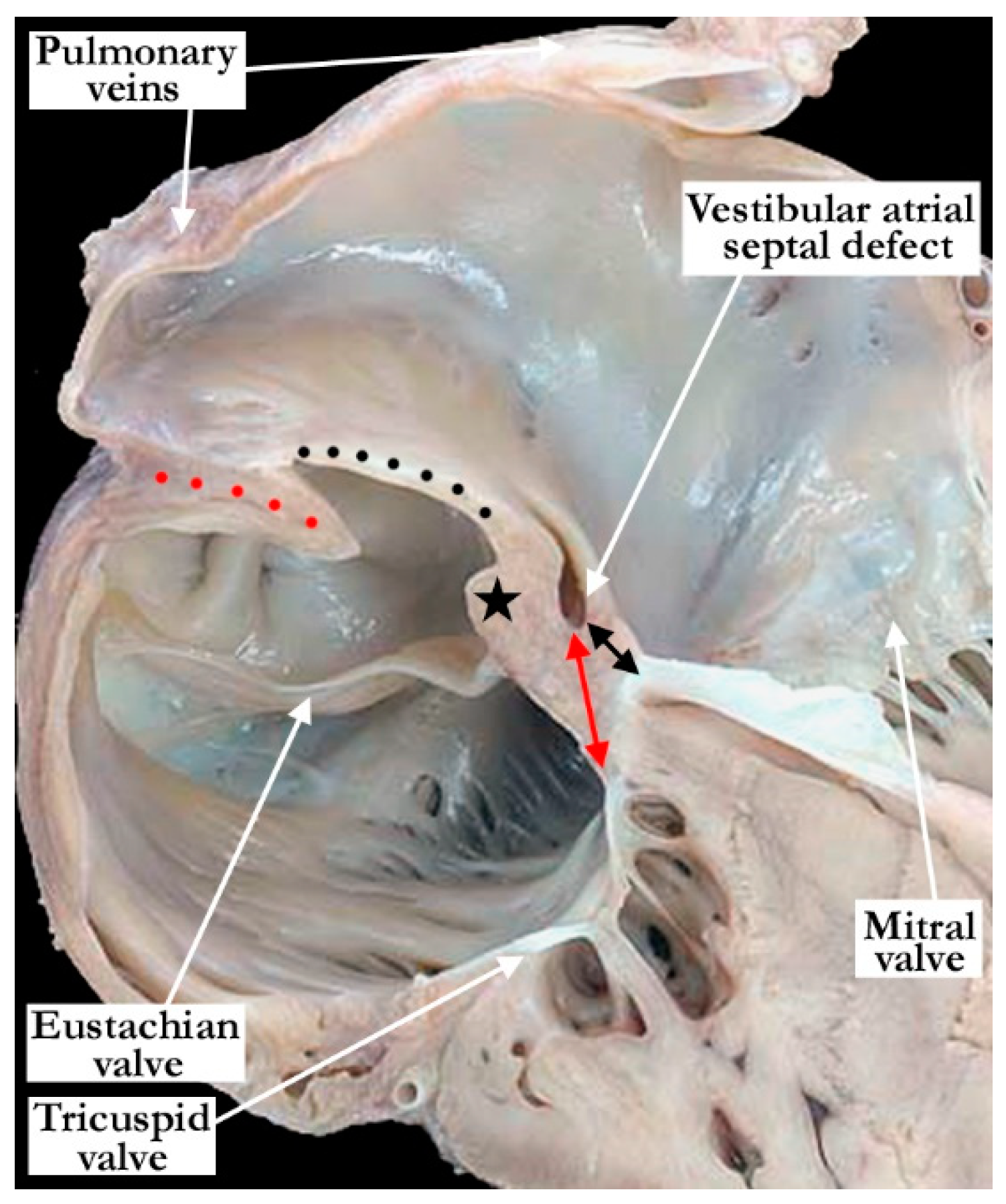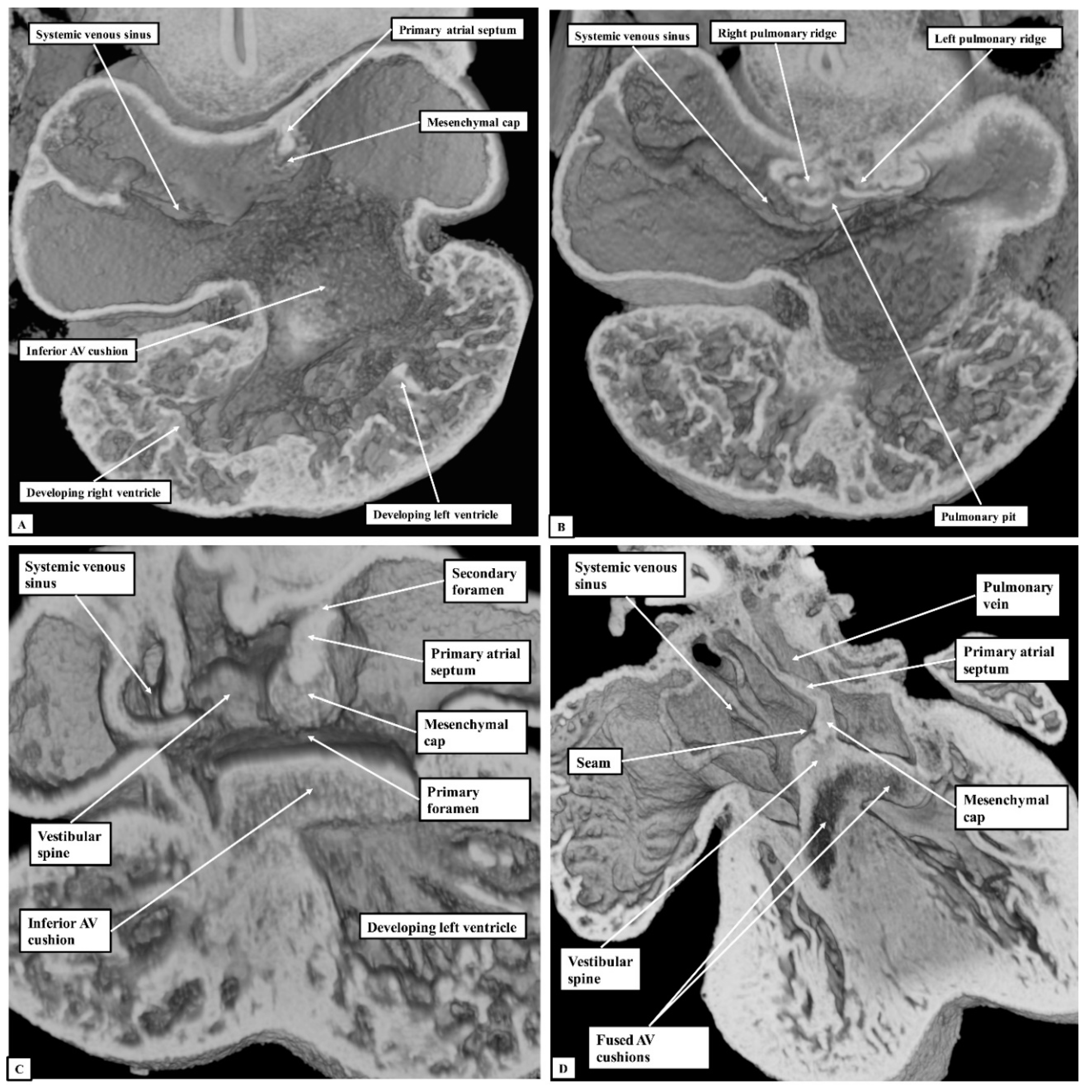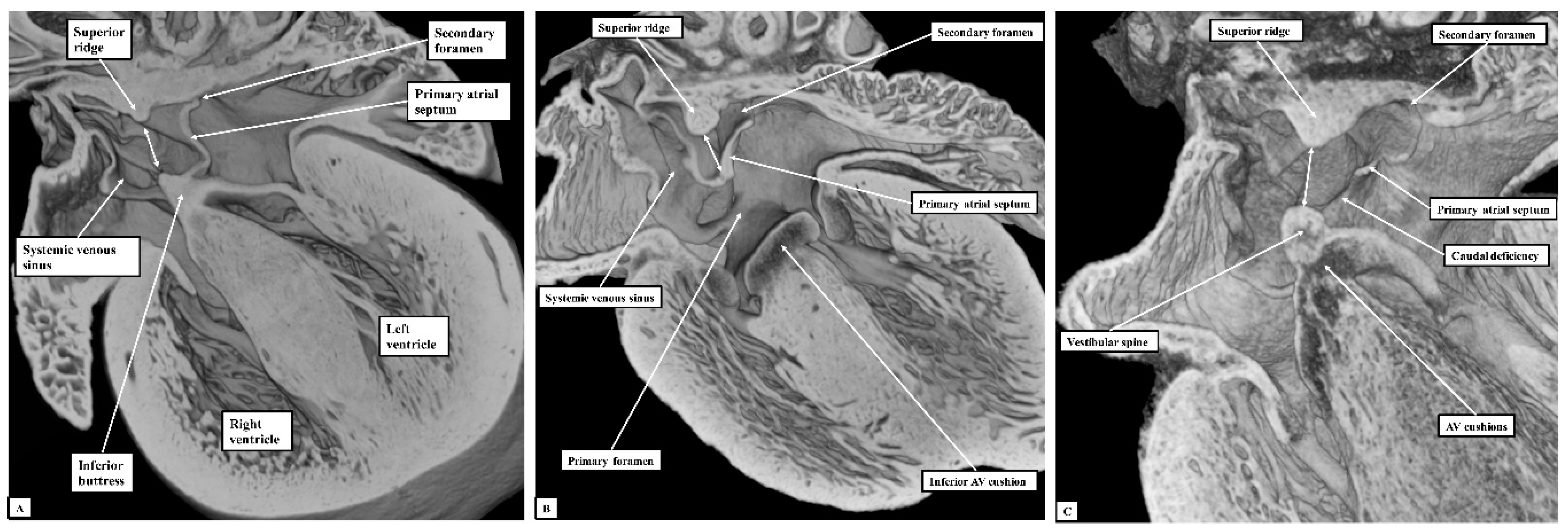3.1. Human Necroscopy Specimens
We analyzed a total of 2100 specimens, with 68 (3%) found to have a vestibular atrial septal defect. We use this denominator of 68 hearts with vestibular atrial septal defects for our subsequent descriptions. All the defects were found in the antero-inferior muscular rim of the oval fossa, typically in the area antero-superior to the mouth of the coronary sinus (
Figure 1). This area, which provides the antero-inferior muscular buttress of the oval fossa, includes the narrow vestibule of the right atrium that lies between the antero-inferior rim and the hinge of the septal leaflet of the tricuspid valve. A slight variation was observed in the position of the defect, with its size also varying (
Figure 2). Some of the defects were slit-like and tiny, but large defects were also found, as in one of the hearts examined from an adult patient (
Figure 2). The defects opened to the left atrium adjacent to the hinges of the leaflets of the mitral valve, with retention of the normal off-setting of the hinges of the atrioventricular valvar leaflets in the hearts having separate atrioventricular junctions (
Figure 3).
In terms of associated lesions, all hearts had a usual atrial arrangement, with right-sided superior caval veins that drained into the roof of the right-sided atrium. A left-sided superior caval vein was present in four (6%) of the hearts, in all instances draining into the coronary sinus. The pulmonary veins returned to the left atrium in a normal fashion in all of the specimens. The morphologically right atrium was dilated in 42 hearts (62%), with the morphologically left atrium being dilated in 20 (29%), and hypoplastic in two (3%). An additional defect was present in the oval fossa in 53 hearts (78%), with an additional coronary sinus interatrial communication found in three (4%). A common atrioventricular junction was present in 10 (15%), accompanied by the anticipated “ostium primum” atrial component of the associated atrioventricular septal defect. In these hearts, the atrial septum itself was well-formed, with a recognizable oval fossa. The vestibular defect itself was in the leading edge of the septum, adjacent to the “ostium primum” defect (
Figure 4). The atrioventricular connections were concordant in 65 (94%), discordant in one (2%), solitary and right-sided in one (2%), and solitary and left-sided in one (2%). An abnormality of the right-sided atrioventricular valve was noted in 40 hearts (59%), with a left-sided atrioventricular valvar abnormality noted in 19 (28%). Abnormalities of the atrioventricular valves included both stenosis and dysplasia. Ventricular topology was right-handed in all the hearts except for the one with discordant atrioventricular connections (98%). The ventriculo-arterial connections were concordant in 60 (89%), discordant in five (7%), and double outlet right ventricle in three (4%). Pulmonary atresia was present in 17 hearts (25%), while aortic atresia was present in one (2%). The aorta was most commonly posterior and rightward (58, 84%). Right ventricular outflow tract obstruction was present in 37, (58%) most commonly at the level of the arterial valve. An interventricular communication was present in 31 (46%). The aortic arch coursed over the left-sided pulmonary artery and bronchus in 66 (98%). Coarctation of the aorta was present in four (6%), with interruption of the aortic arch present in two (3%). The coronary arterial origins were abnormal in three (6%). An arterial duct was present in 33 (49%), ligated in eight (11%), and absent in 27 (40%). The cardiac apex was leftward in all but one heart, which had an apex that was pointed towards the midline. A history of trisomy 21 was documented in five patients (7%), with a history of 22 q deletion documented in one (2%).
3.2. Developmental Considerations
Since the defects observed in the autopsied hearts were all found either within the antero-inferior buttress of the oval fossa, or at the site of anchorage of the floor of the fossa to the buttress, we reasoned that knowledge of normal development of the atrial septum might permit us better to understand the morphology and location of the defects. We studied, therefore, the temporal changes occurring during septation of the atrial chambers in the mouse heart, taking advantage of our access to over 400 datasets prepared from developing mouse embryos which cover the period from the eleventh day of intrauterine development to term, which in the mouse usually occurs on the nineteenth day of development. The key stages take place during embryonic day (E) 10.5, with the initial appearance of the primary atrial septum, and continue through E13.5, when it is possible to recognise the margins of the oval fossa, along with the formation of the oval foramen (foramen ovale). Persistent patency of the oval foramen, of course, continues until term. The foramen, nonetheless, is capable of being closed from E13.5 until term in the developing murine heart. The floor of the fossa, derived from the primary atrial septum, is itself usually intact from E13.5 onwards to term. The period from E10.5 through E13.5 corresponds to the sixth through the eighth week of human intrauterine development.
At E10.5, the primary atrial septum can be recognised as a muscular ridge growing from the roof of the atrial component of the heart tube, which is a common structure at this stage of development. By this stage, the borders of the confluence of the systemic venous tributaries with the common atrial cavity are already marked by the venous valves, with the opening of the systemic venous sinus already committed to the right side of the developing atrial chamber (
Figure 5A). The atrioventricular canal at this early stage is committed exclusively to the cavity of the developing left ventricle, although the parietal wall of the right atrium is already in continuity with the wall of the developing right ventricle in the roof of the embryonic interventricular communication. The primary septum itself carries a mesenchymal cap on its leading edge, with the space between the cap and the atrioventricular cushions representing the primary atrial foramen. Dorsally at this stage, the atrial walls are continuous with the pharyngeal mesenchyme through the persisting mesocardial connection. Growth from the mesenchyme into the right margin of the mesocardium has already produced inequality in size of its rims, which now protrude into the atrial cavity as the pulmonary ridges (
Figure 5B). As yet, there is no formation of the pulmonary veins, but the floor of the dorsal mesocardial connection, known as the pulmonary pit, will eventually provide the site of connection between the developing pulmonary veins and the atrial cavity.
By the next day of intrauterine development (E11.5—
Figure 5C), the primary atrial septum has grown towards the cushions developed within the atrioventricular canal. The canal itself has now expanded rightwards so as to bring the cavity of the right atrium into direct connection with that of the right ventricle. The upper margin of the primary foramen has now broken away from the atrial roof to form the secondary atrial foramen, while the size of the primary foramen is much reduced. By now, the growth of mesenchymal tissue into the rightward margin of the dorsal mesocardial connection has produced an intraluminal swelling that overlaps the rightward and dorsal extent of the leading edge of the primary atrial septum. This is the vestibular spine, also known as the dorsal mesenchymal protrusion. The pulmonary vein by this stage has canalised within the pharyngeal mesenchyme, opening to the atrium through the pulmonary pit. The growth of the vestibular spine ensures that the pulmonary venous orifice is committed to the developing left atrium. By E13.5, the mesenchymal cap on the atrial septum has fused with the atrial margins of the atrioventricular cushions, which themselves have fused together to separate the atrioventricular canal into the developing tricuspid and mitral valvar orifices (
Figure 5D—Lower right-hand panel). The rightward margin of the cap is now itself overlapped by the vestibular spine, with an obvious seam noted between these structures. The two entities together form the caudal rim of the developing oval fossa. Both by now are losing their mesenchymal characteristics and are attaining the same texture of the walls of the cardiac chambers, which we interpret as indicating their muscularisation. The cranial margin of the fossa can now be recognised as a small ridge formed to the right side of the cranial attachment of the primary atrial septum.
If development proceeds in a normal fashion, the margins of the oval fossa are intact by E15.5. We examined episcopic datasets prepared from 48 mouse embryos at this stage. In 38 of the mice, the findings show the normal arrangement, with the primary septum folded on itself cranially, its length being considerably greater than the length of the fossa (
Figure 6A). In these 38 datasets, the vestibular spine and mesenchymal cap fused together to form the caudal rim of the fossa, with obliteration of the seam initially seen between the two components during E13.5 (
Figure 5D). The primary septum now forms the floor of the oval fossa, with the space between its cranial margin and the atrial roof forming the oval foramen, or secondary atrial foramen. The excessive length of the septum relative to the dimensions of the fossa provides the mechanism that permits closure of the foramen subsequent to birth. In 10 of the datasets prepared from mice sacrificed at E15.5, however, we found deficiencies of either the inferior rim of the oval fossa, or the attachment of the leading edge of the primary septum. In two, the findings could be attributed to the failure of formation of the vestibular spine (
Figure 6B), with additional failure of growth of the primary septum in one of the two. In both, the lack of growth of the spine was associated with persistence of a common atrioventricular junction, with the atrioventricular cushions fused to each other, and also to the crest of the muscular ventricular septum, in other words producing an “ostium primum” defect. In four further datasets, although the vestibular spine had protruded in anticipated fashion to form the caudal margin of the oval fossa, thus separating the right and left atrioventricular junctions and forming the caudal rim of the fossa, the primary septum itself was deficient adjacent to the caudal rim, thus producing a hole in the floor of the fossa adjacent to its antero-inferior buttress, in other words, an “ostium secundum” defect (
Figure 6C) The defect was large in two of the datasets but smaller in the remaining two. In the remaining four datasets, the mesenchymal cap had failed to fuse with the vestibular spine. The spaces in the floor of the oval fossa in these four hearts (
Figure 7), therefore, are directly comparable to the vestibular defects found in our autopsied hearts.
